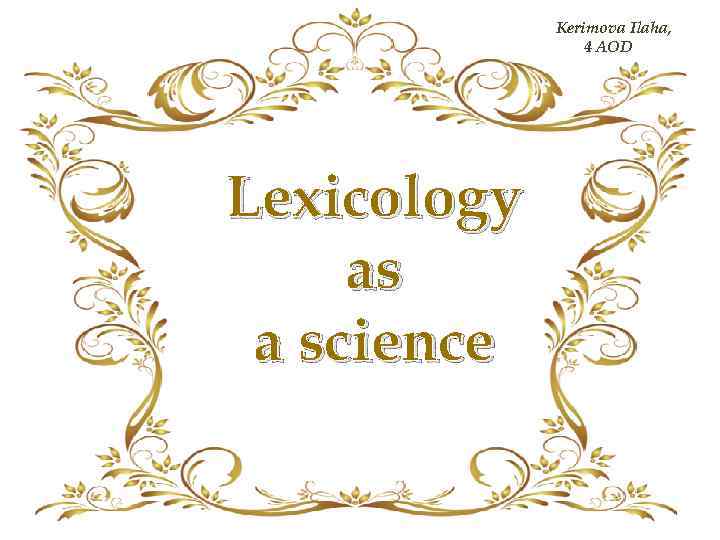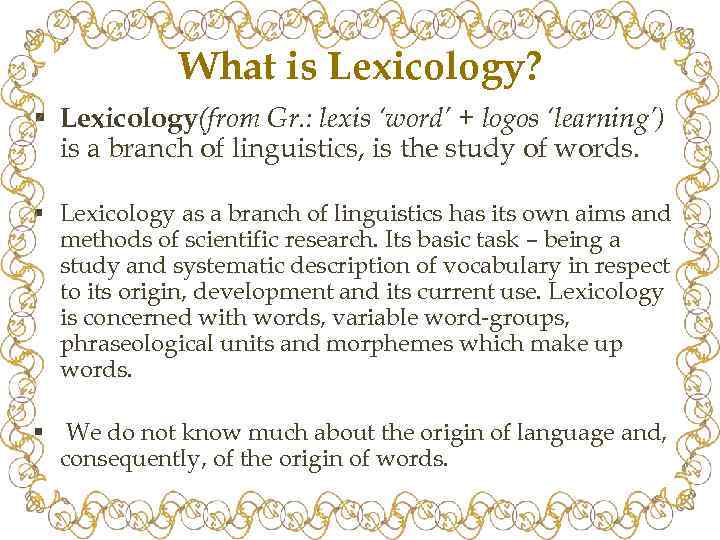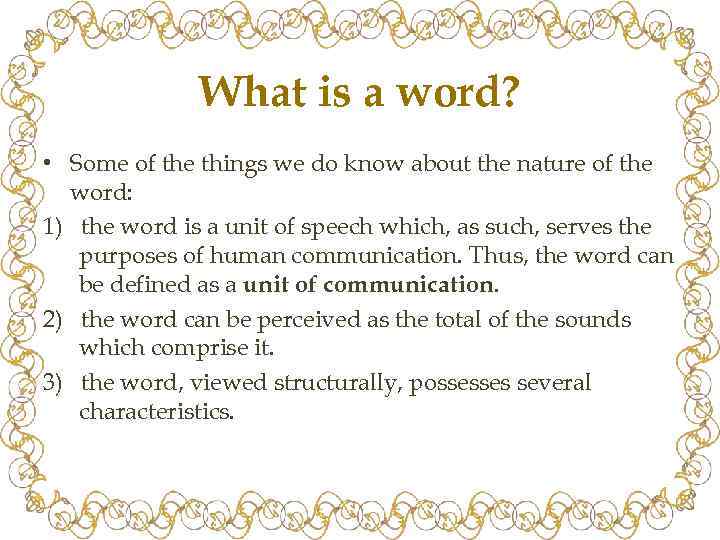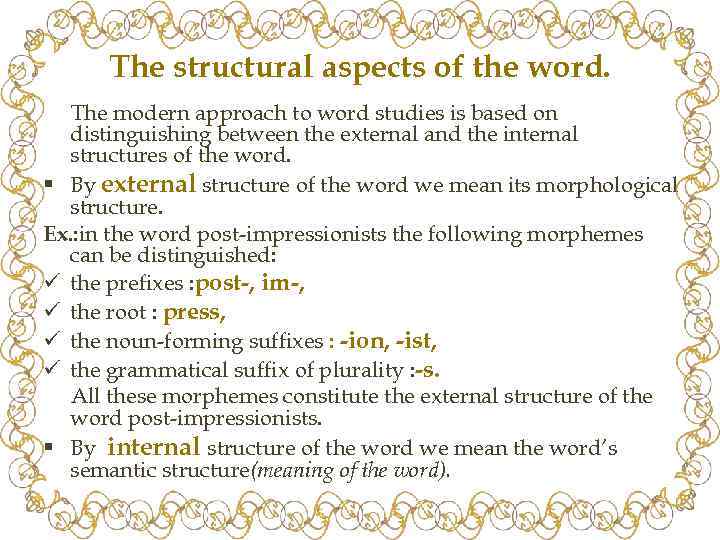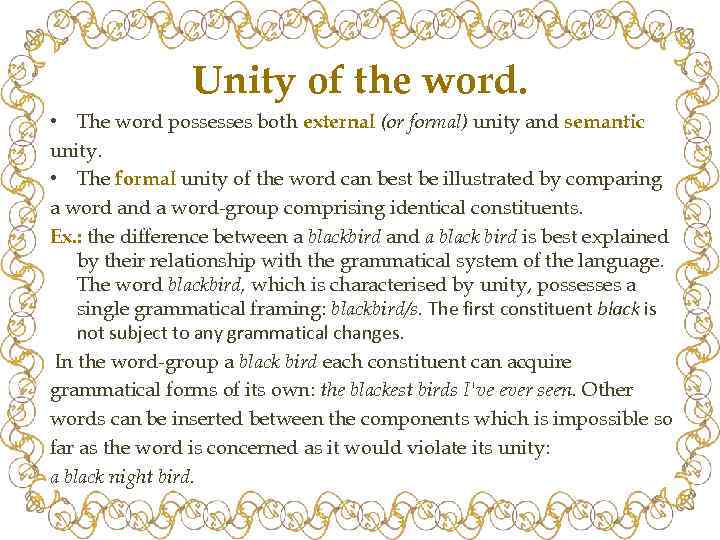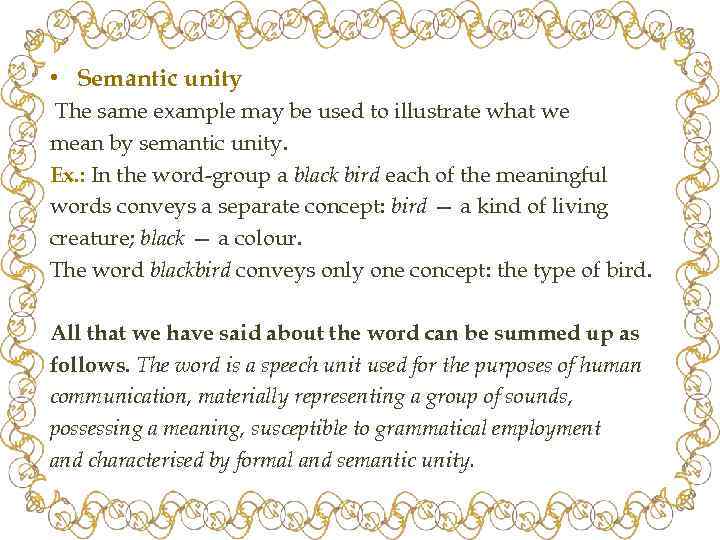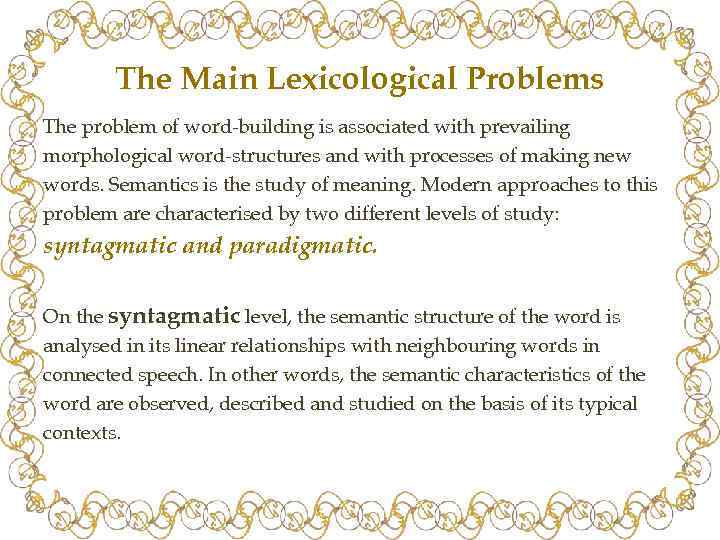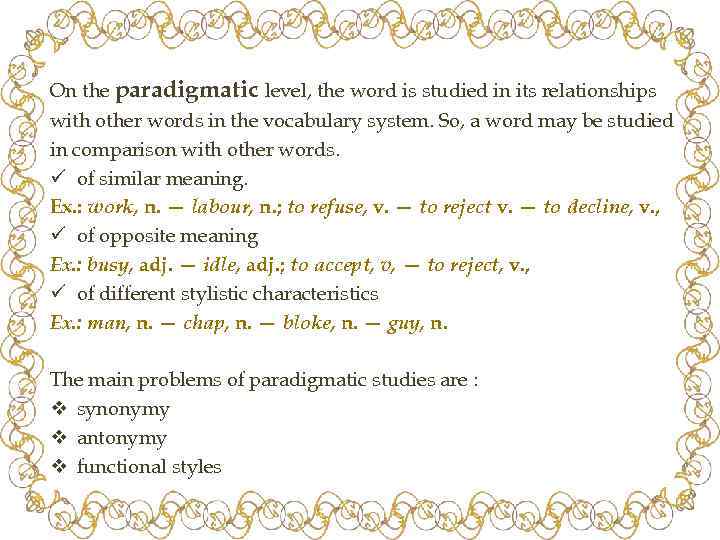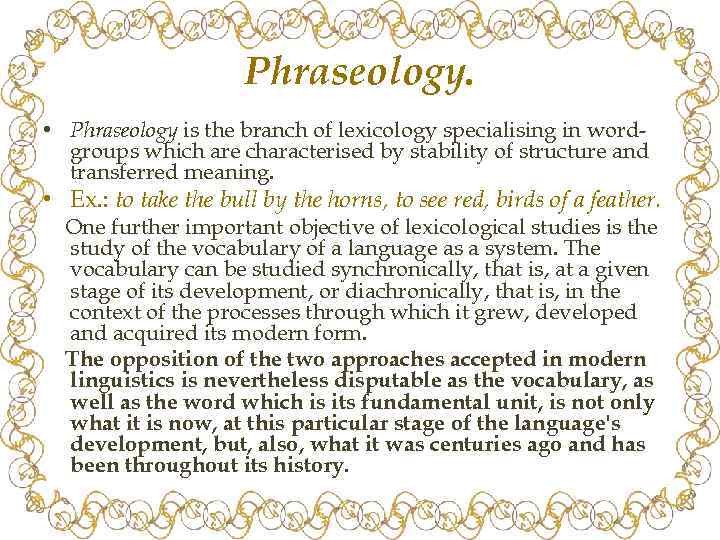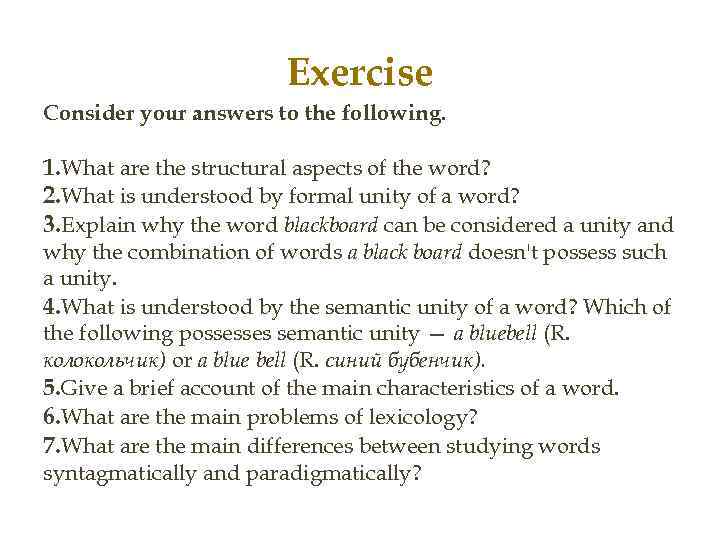1. Ефименко А.З. Цены и ценовая политика. // Экономика строительства. — 2000. — №1. — С.54-61.
2. Цены и ценообразование: Учебник для вузов / Под ред. И.К. Салимжанова. — М.: ЗАО «Финстатинформ», 2003.
3. Дерябин А.А. Система ценообразования и финансов, пути совершенствования. М., Экономика, 2001
4. Певший Ф.М. Мировой рынок, конъюнктура, цены и маркетинг. М., МО, 2003
5. Ценообразование и рынок под ред. Салижманова И.K. М., Финстатинформ, колл. авторов, М., Прогресс, 2002
The Object of Lexicology
Antrushina G.B. English Lexicology
(pp. 6 – 11)
1. What is lexicology?
2. The structure of the word.
3. The main problems of lexicology.
4. Phraseology.
5. Vocabulary as a system.
What’s in a name? that which we call a rose
By any other name would smell as sweet…
(W. Shakespeare. Romeo and Juliet)
Что в имени твоём? То, что зовём мы розой, —
И под другим названьем сохраняло б
Свой сладкий запах!
(перевод Щепкиной-Куперник)
1. What is lexicology?
These famous lines reflect one of the fundamental problems of linguistic research: what is in a name, in a word? Is there any direct connection between a word and the object it represents? Could a rose have been called by “any other name” as Juliet says?
These and similar questions are answered by lexicological research. Lexicology,a branch of linguistics, is the study of words.
“Lexicology (from Gr lexis ‘word’ and logos ‘learning’) is the part of linguistics dealing with the vocabulary of a language and the properties of words as the main units of language. The term vocabulary is used to denote the system formed by the sum total of all the words that the language possesses.
The term word denotes the basic unit of a given language resulting from the association of a particular meaning with a particular group of sounds capable of a particular grammatical employment. A word therefore is simultaneously a semantic, grammatical and phonological unit.”
(I. Arnold, Lexicology, p.9)
We do not know much about the origin of language and, consequently, of the origin of words. We know almost nothing about the mechanism by which a speaker’s mental process is converted into sound groups called “words”, nor about the reverse process whereby a listener’s brain converts the acoustic phenomena into concepts and ideas, thus establishing a two-way process of communication.
We know very little about the nature of relations between the word and the referent (i.e. object, phenomenon, quality, action, etc. denoted by the word). If we assume that there is a direct relation between the word and the referent it gives rise to another question: how should we explain the fact that the same referent is designated by quite different sound groups in different languages.
We do know by now that there is nothing accidental about the vocabulary of the language (the total sum of its words);that each word is a small unit within a vast, efficient and perfectly balanced system.
What do we know about the nature of the word?
First, we know that the word is a unit of speech which serves the purposes of human communication. Thus, the word can be defined as a unit of communication.
Secondly, the word can be perceived as the total of the sounds which comprise it.
Third, the word, viewed structurally, possesses several characteristics.
The structure of the word
The modern approach to word studies is based on distinguishing between the external and the internal structures of the word.
By external structure of the word we mean its morphological structure. For example, in the word post-impressionists the following morphemes can be distinguished: the prefixes post-, im-, the root press, the noun-forming suffixes — ion, — ist, and the grammatical suffix of plurality -s. All these morphemes constitute the external structure of the word post-impressionists.
The internal structure of the word,or its meaning,is commonly referred to as the word’s semantic structure. This is the word’s main aspect. Words can serve the purposes of human communication solely due to their meanings.
The area of lexicology specializing in the semantic studies of the word is called semantics.
Another structural aspect of the word is its unity. The word possesses both external (or formal) unity and semantic unity. Formal unity of the word is sometimes interpreted as indivisibility. The example of post-impressionists has already shown that the word is not indivisible. Yet, its component morphemes are permanently linked together in opposition to word-groups, both free and with fixed contexts, whose components possess a certain structural freedom, e.g. bright light, to take for granted.
The formal unity of the word can best be illustrated by comparing a word and a word-group comprising identical constituents. The difference between a blackbird and a black bird is explained by their relationship with the grammatical system of the language. The word blackbird, which is characterized by unity, possesses a single grammatical framing: blackbird/s. The first constituent black is not subject to any grammatical changes. In the word-group a black bird each constituent can acquire grammatical forms of its own: the blackest birds I’ve ever seen. Other words can be inserted between the components: a black night bird.
The same example may be used to illustrate what we mean by semantic unity.
In the word-group a black bird each of the meaningful words conveys a separate concept: bird – a kind of living creature; black – a colour.
The word blackbird conveys only one concept: the type of bird. This is one of the main features of any word: it always conveys one concept, no matter how many component morphemes it may have in its external structure.
A further structural feature of the word is its susceptibility to grammatical employment. In speech most words can be used in different grammatical forms in which their interrelations are realized.
All that we have said about the word can be summed up as follows.
The word is a speech unit used for the purposes of human communication, materially representing a group of sounds, possessing a meaning, susceptible to grammatical employment and characterized by formal and semantic unity.
|
Важнейшие способы обработки и анализа рядов динамики Не во всех случаях эмпирические данные рядов динамики позволяют определить тенденцию изменения явления во времени… |
ТЕОРЕТИЧЕСКАЯ МЕХАНИКА Статика является частью теоретической механики, изучающей условия, при которых тело находится под действием заданной системы сил… |
Теория усилителей. Схема Основная масса современных аналоговых и аналого-цифровых электронных устройств выполняется на специализированных микросхемах… |
Логические цифровые микросхемы Более сложные элементы цифровой схемотехники (триггеры, мультиплексоры, декодеры и т.д.) не имеют… |
|
Патристика и схоластика как этап в средневековой философии Основной задачей теологии является толкование Священного писания, доказательство существования Бога и формулировка догматов Церкви… Основные симптомы при заболеваниях органов кровообращения При болезнях органов кровообращения больные могут предъявлять различные жалобы: боли в области сердца и за грудиной, одышка, сердцебиение, перебои в сердце, удушье, отеки, цианоз головная боль, увеличение печени, слабость… Вопрос 1. Коллективные средства защиты: вентиляция, освещение, защита от шума и вибрации Коллективные средства защиты: вентиляция, освещение, защита от шума и вибрации |
The
modern approach to word studies is based on distinguishing between
the external
and
the
internal structures
of the word.
By
external
structure of the word we
mean its morphological
structure.
For example, in the word post-impressionists
the
following morphemes can be distinguished: the prefixes post-,
im-, the
root press,
the
noun-forming suffixes —ion,
—ist,
and the grammatical suffix of plurality -s.
All these morphemes constitute the external structure of the word
post-impressionists.
The
internal
structure of the word, or
its meaning,
is
commonly referred to as the word’s semantic
structure. This
is the word’s main aspect. Words can serve the purposes of human
communication solely due to their meanings.
The
area of lexicology specializing in the semantic studies of the word
is called semantics.
Another
structural aspect of the word is its unity.
The word possesses both external (or formal) unity and semantic
unity. Formal unity of the word is sometimes interpreted as
indivisibility. The example of post-impressionists
has
already shown that the word is not indivisible. Yet, its component
morphemes are permanently linked together in opposition to
word-groups, both free and with fixed contexts, whose components
possess a certain structural freedom, e.g. bright
light, to take for granted.
The
formal unity of the word can best be illustrated by comparing a word
and a word-group comprising identical constituents. The difference
between a
blackbird and
a black bird is
explained by their relationship with the grammatical system of the
language. The word blackbird,
which
is characterized by unity, possesses a single grammatical framing:
blackbird/s.
The
first constituent black
is
not subject to any grammatical changes. In the word-group a black
bird each
constituent can acquire grammatical forms of its own: the
blackest birds I’ve ever seen. Other
words can be inserted between the components: a
black night bird.
The
same example may be used to illustrate what we mean by semantic
unity.
In
the word-group a black
bird each
of the meaningful words conveys a separate concept: bird
– a
kind of living creature; black
– a
colour.
The
word blackbird
conveys
only one concept: the type of bird. This is one of the main features
of any word: it always conveys one concept, no matter how many
component morphemes it may have in its external structure.
A
further structural feature of the word is its susceptibility
to
grammatical employment. In speech most words can be used in different
grammatical forms in which their interrelations are realized.
All
that we have said about the word can be summed up as follows.
The
word
is
a speech unit used for the purposes of human communication,
materially representing a group of sounds, possessing a meaning,
susceptible to grammatical employment and characterized by formal and
semantic unity.
-
The main problems of lexicology
Two
of these have been already underlined. The
problem of word-building is
associated with prevailing morphological word-structures and with
processes of making new words. Semantics
is
the study of meaning. Modern approaches to this problem are
characterized by two different levels of study: syntagmatic
and
paradigmatic.
On
the syntagmatic
level, the
semantic structure of the word is analysed in its linear
relationships with neighbouring words in connected speech. In other
words, the semantic characteristics of the word are observed,
described and studied on the basis of its typical contexts.
On
the paradigmatic
level, the
word is studied in its relationships with other words in the
vocabulary system. So, a word may be studied in comparison with other
words of similar meaning. E.g. work
n – labour
n.
Work работа,
труд; 1
the
job that a person does especially in order to earn money. This word
has many meanings (in
Oxford Dictionary – 14),
many synonyms and idioms [`idiemz]: creative
work творческая
деятельность; public
work общественные
работы;
his life`s work дело
его жизни; dirty
work (difficult,
unpleasant) 1
чёрная работа; 2
грязное
дело, подлость.
Nice
work! Отлично!
Здорово!
Saying (поговорка):
All
work and no play makes Jack a dull boy (мешай
дело с бездельем, проживёшь век с
весельем)
–
it is not healthy to spend all your time working; you need to relax
too.
Labour:
“work”
и “labour” не взаимозаменимы; labour
– 1 work,
especially physical work: manual
labour,
a
labour camp
– исправительно-трудовой
лагерь; 2
people
who work: a
shortage of labour; cheap labour; skilled labour –
квалифицированные
рабочие, Labour
Party; labour relations; a labour of
Sisyphus;
Sisyphean
labour [,sisi‘fi:en]
сизифов труд; тяжёлый и бесплодный труд
– of a task impossible to complete. From the Greek myth in which
Sisyphus was punished for the bad things he had done in his life with
the never-ending task of rolling a large stone to the top of a hill,
from which it always rolled down again.
Other
words of similar meaning (e.g. to
refuse v – to reject v),
of
opposite meaning (e.g. busy
adj – idle adj; to accept v – to reject v),
of
different stylistic characteristics (e.g. man
n – chap n – bloke n – guy n).
Man
–
chap
(coll.)
–
парень, малый; a
good chap
–
славный малый; old
chap – старина;
chap
– BrE,
informal,
becoming old-fashioned – used to talk about a man in a friendly
way: He
isn`t such a bad chap really. Bloke
(coll.)
тип,
парень: He
seemed like a nice bloke.
Guy
– coll.
US – малый;
tough
guy железный
малый; wise
guy умник;
guys
(informal,
especially US) a
group of people of either sex: Come
on, you guys!
Consequently,
the main problems of paradigmatic studies are synonymy,
antonymy, functional styles.
Соседние файлы в предмете [НЕСОРТИРОВАННОЕ]
- #
- #
- #
- #
- #
- #
- #
- #
- #
- #
- #
Слайд 1Lexicology
as
a science
Kerimova Ilaha,
4 AOD
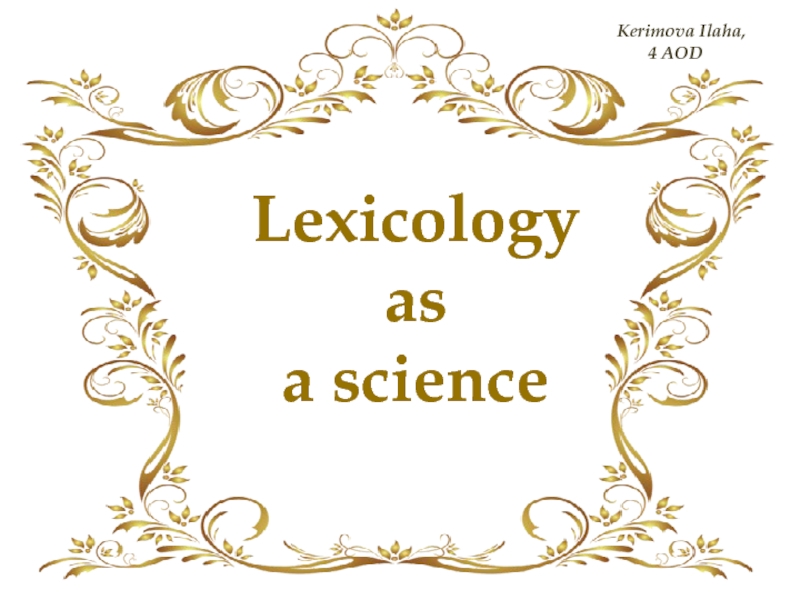
Слайд 2What is Lexicology?
Lexicology(from Gr.: lexis ‘word’ + logos ‘learning’) is a branch of linguistics,
is the study of words.
Lexicology as a branch of
linguistics has its own aims and methods of scientific research. Its basic task – being a study and systematic description of vocabulary in respect to its origin, development and its current use. Lexicology is concerned with words, variable word-groups, phraseological units and morphemes which make up words.
We do not know much about the origin of language and, consequently, of the origin of words.
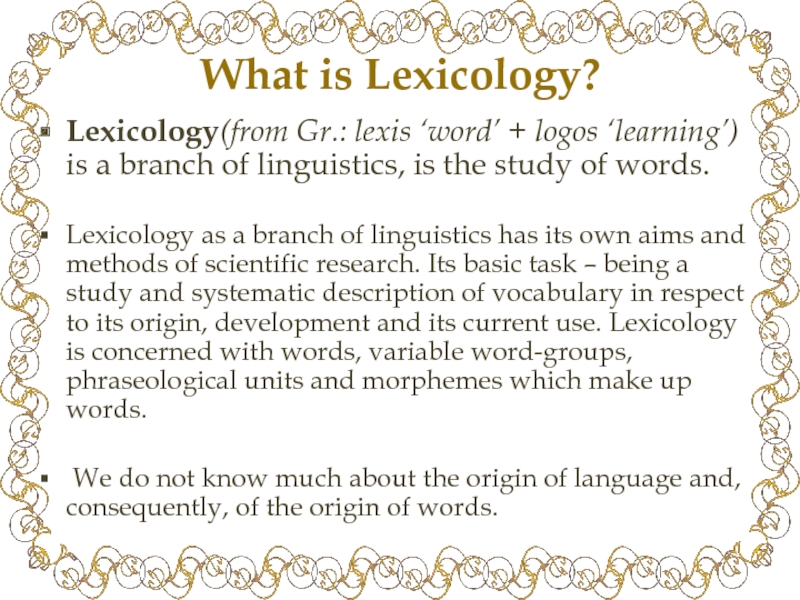
Слайд 3What is a word?
Some of the things we do know
about the nature of the word:
1) the word is
a unit of speech which, as such, serves the purposes of human communication. Thus, the word can be defined as a unit of communication.
2) the word can be perceived as the total of the sounds which comprise it.
3) the word, viewed structurally, possesses several characteristics.
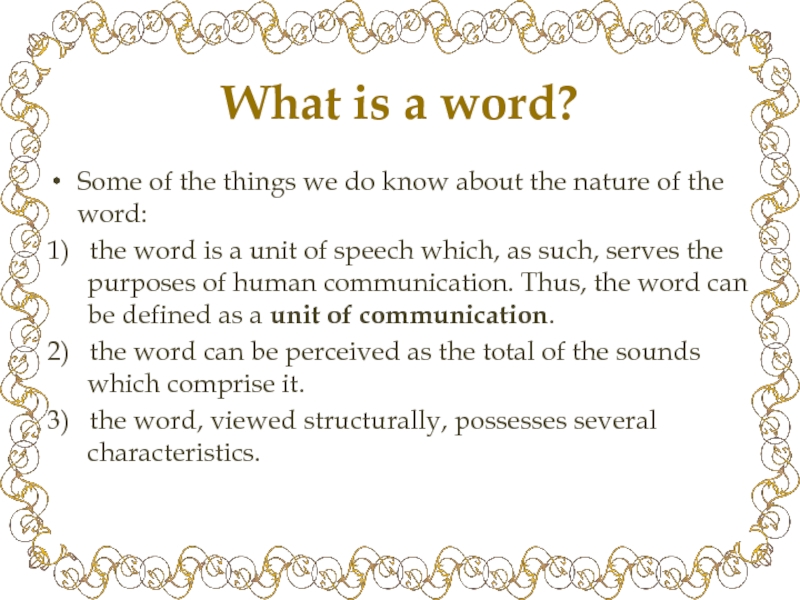
Слайд 4The structural aspects of the word.
The modern
approach to word studies is based on distinguishing between the
external and the internal structures of the word.
By external structure of the word we mean its morphological structure.
Ex.:in the word post-impressionists the following morphemes can be distinguished:
the prefixes :post-, im-,
the root : press,
the noun-forming suffixes : -ion, -ist,
the grammatical suffix of plurality :-s.
All these morphemes constitute the external structure of the word post-impressionists.
By internal structure of the word we mean the word’s semantic structure(meaning of the word).
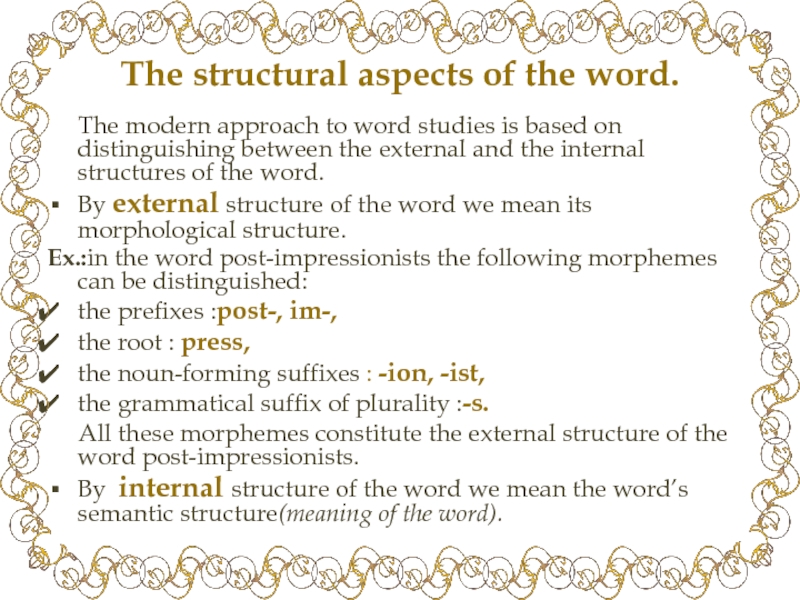
Слайд 5Unity of the word.
The word possesses both external (or formal)
unity and semantic
unity.
The formal unity of the word can best
be illustrated by comparing
a word and a word-group comprising identical constituents.
Ex.: the difference between a blackbird and a black bird is best explained by their relationship with the grammatical system of the language. The word blackbird, which is characterised by unity, possesses a single grammatical framing: blackbird/s. The first constituent black is not subject to any grammatical changes.
In the word-group a black bird each constituent can acquire
grammatical forms of its own: the blackest birds I’ve ever seen. Other
words can be inserted between the components which is impossible so
far as the word is concerned as it would violate its unity:
a black night bird.
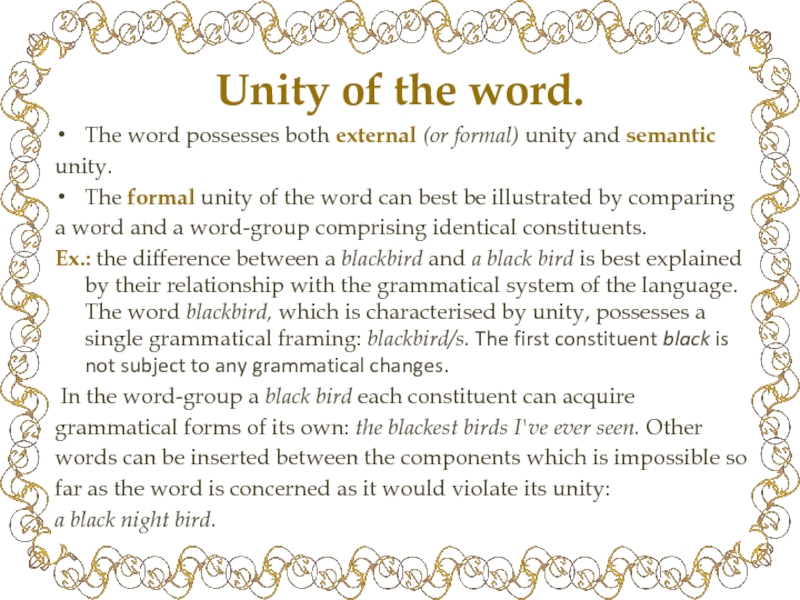
Слайд 6Semantic unity
The same example may be used to illustrate
what we
mean by semantic unity.
Ex.: In the word-group a black
bird each of the meaningful
words conveys a separate concept: bird — a kind of living
creature; black — a colour.
The word blackbird conveys only one concept: the type of bird.
All that we have said about the word can be summed up as
follows. The word is a speech unit used for the purposes of human
communication, materially representing a group of sounds,
possessing a meaning, susceptible to grammatical employment
and characterised by formal and semantic unity.
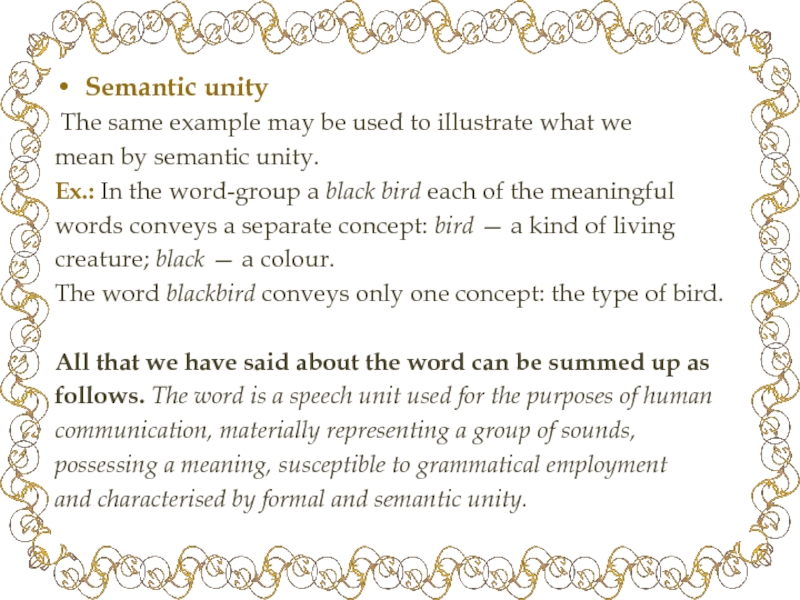
Слайд 7
The Main Lexicological Problems
The problem of word-building is associated with
prevailing
morphological word-structures and with processes of making new
words. Semantics is
the study of meaning. Modern approaches to this
problem are characterised by two different levels of study:
syntagmatic and paradigmatic.
On the syntagmatic level, the semantic structure of the word is
analysed in its linear relationships with neighbouring words in
connected speech. In other words, the semantic characteristics of the
word are observed, described and studied on the basis of its typical
contexts.
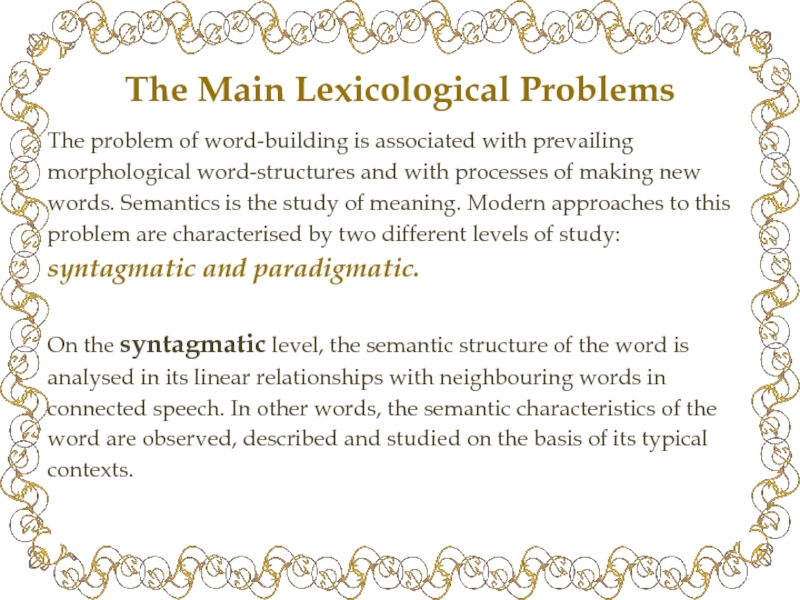
Слайд 8On the paradigmatic level, the word is studied in its
relationships
with other words in the vocabulary system. So, a word
may be studied
in comparison with other words.
of similar meaning.
Ex.: work, n. — labour, n.; to refuse, v. — to reject v. — to decline, v.,
of opposite meaning
Ex.: busy, adj. — idle, adj.; to accept, v, — to reject, v.,
of different stylistic characteristics
Ex.: man, n. — chap, n. — bloke, n. — guy, n.
The main problems of paradigmatic studies are :
synonymy
antonymy
functional styles
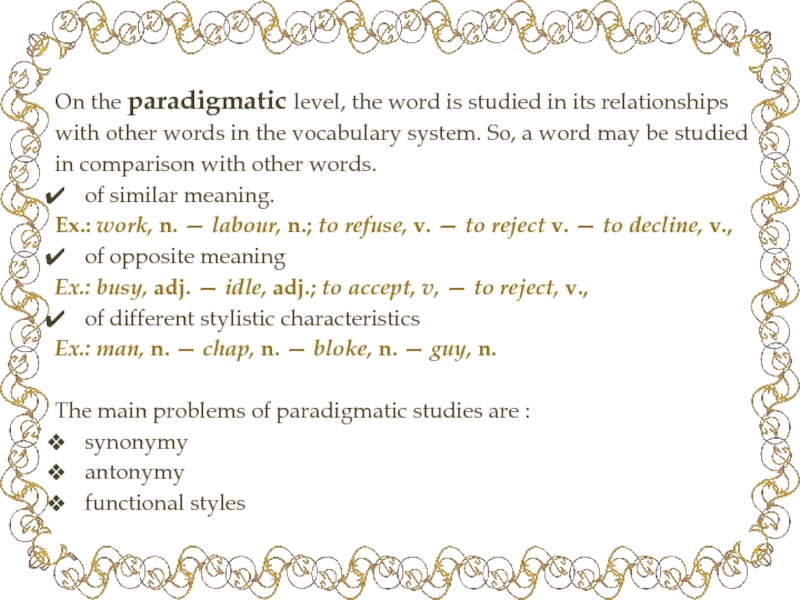
Слайд 9Phraseology.
Phraseology is the branch of lexicology specialising in word-groups which
are characterised by stability of structure and transferred meaning.
Ex.: to
take the bull by the horns, to see red, birds of a feather.
One further important objective of lexicological studies is the study of the vocabulary of a language as a system. The vocabulary can be studied synchronically, that is, at a given stage of its development, or diachronically, that is, in the context of the processes through which it grew, developed and acquired its modern form.
The opposition of the two approaches accepted in modern linguistics is nevertheless disputable as the vocabulary, as well as the word which is its fundamental unit, is not only what it is now, at this particular stage of the language’s development, but, also, what it was centuries ago and has been throughout its history.
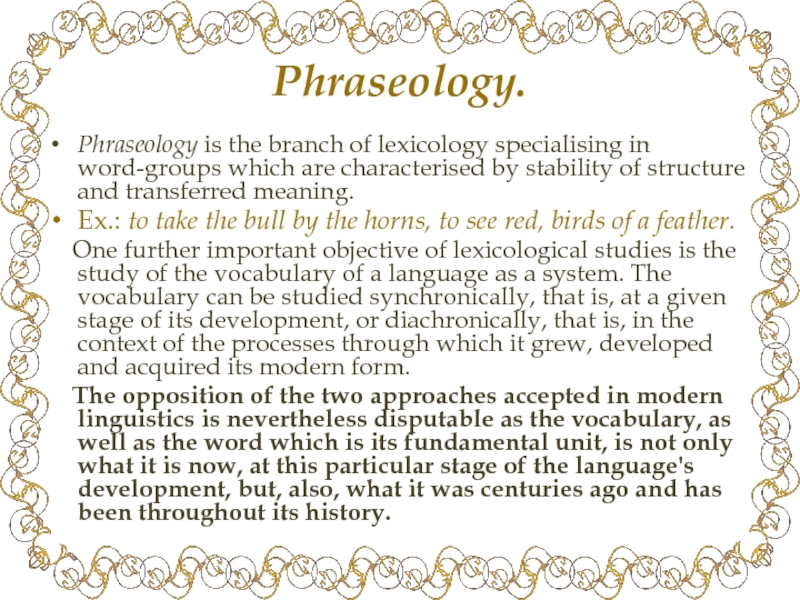
Слайд 10
Exercise
Consider your answers to the following.
1.What are the structural aspects
of the word?
2.What is understood by formal unity of a
word?
3.Explain why the word blackboard can be considered a unity and
why the combination of words a black board doesn’t possess such
a unity.
4.What is understood by the semantic unity of a word? Which of
the following possesses semantic unity — a bluebell (R.
колокольчик) or a blue bell (R. синий бубенчик).
5.Give a brief account of the main characteristics of a word.
6.What are the main problems of lexicology?
7.What are the main differences between studying words
syntagmatically and paradigmatically?
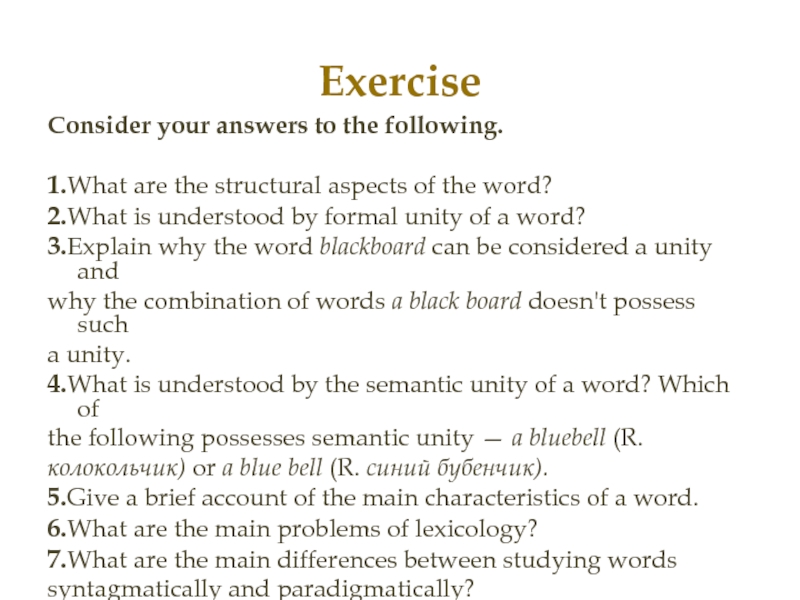
Kerimova Ilaha, 4 AOD Lexicology as a science
What is Lexicology? § Lexicology(from Gr. : lexis ‘word’ + logos ‘learning’) is a branch of linguistics, is the study of words. § Lexicology as a branch of linguistics has its own aims and methods of scientific research. Its basic task – being a study and systematic description of vocabulary in respect to its origin, development and its current use. Lexicology is concerned with words, variable word-groups, phraseological units and morphemes which make up words. § We do not know much about the origin of language and, consequently, of the origin of words.
What is a word? • Some of the things we do know about the nature of the word: 1) the word is a unit of speech which, as such, serves the purposes of human communication. Thus, the word can be defined as a unit of communication. 2) the word can be perceived as the total of the sounds which comprise it. 3) the word, viewed structurally, possesses several characteristics.
The structural aspects of the word. The modern approach to word studies is based on distinguishing between the external and the internal structures of the word. § By external structure of the word we mean its morphological structure. Ex. : in the word post-impressionists the following morphemes can be distinguished: ü the prefixes : post-, im-, ü the root : press, ü the noun-forming suffixes : -ion, -ist, ü the grammatical suffix of plurality : -s. All these morphemes constitute the external structure of the word post-impressionists. § By internal structure of the word we mean the word’s semantic structure(meaning of the word).
Unity of the word. • The word possesses both external (or formal) unity and semantic unity. • The formal unity of the word can best be illustrated by comparing a word and a word-group comprising identical constituents. Ex. : the difference between a blackbird and a black bird is best explained by their relationship with the grammatical system of the language. The word blackbird, which is characterised by unity, possesses a single grammatical framing: blackbird/s. The first constituent black is not subject to any grammatical changes. In the word-group a black bird each constituent can acquire grammatical forms of its own: the blackest birds I’ve ever seen. Other words can be inserted between the components which is impossible so far as the word is concerned as it would violate its unity: a black night bird.
• Semantic unity The same example may be used to illustrate what we mean by semantic unity. Ex. : In the word-group a black bird each of the meaningful words conveys a separate concept: bird — a kind of living creature; black — a colour. The word blackbird conveys only one concept: the type of bird. All that we have said about the word can be summed up as follows. The word is a speech unit used for the purposes of human communication, materially representing a group of sounds, possessing a meaning, susceptible to grammatical employment and characterised by formal and semantic unity.
The Main Lexicological Problems The problem of word-building is associated with prevailing morphological word-structures and with processes of making new words. Semantics is the study of meaning. Modern approaches to this problem are characterised by two different levels of study: syntagmatic and paradigmatic. On the syntagmatic level, the semantic structure of the word is analysed in its linear relationships with neighbouring words in connected speech. In other words, the semantic characteristics of the word are observed, described and studied on the basis of its typical contexts.
On the paradigmatic level, the word is studied in its relationships with other words in the vocabulary system. So, a word may be studied in comparison with other words. ü of similar meaning. Ex. : work, n. — labour, n. ; to refuse, v. — to reject v. — to decline, v. , ü of opposite meaning Ex. : busy, adj. — idle, adj. ; to accept, v, — to reject, v. , ü of different stylistic characteristics Ex. : man, n. — chap, n. — bloke, n. — guy, n. The main problems of paradigmatic studies are : v synonymy v antonymy v functional styles
Phraseology. • Phraseology is the branch of lexicology specialising in wordgroups which are characterised by stability of structure and transferred meaning. • Ex. : to take the bull by the horns, to see red, birds of a feather. One further important objective of lexicological studies is the study of the vocabulary of a language as a system. The vocabulary can be studied synchronically, that is, at a given stage of its development, or diachronically, that is, in the context of the processes through which it grew, developed and acquired its modern form. The opposition of the two approaches accepted in modern linguistics is nevertheless disputable as the vocabulary, as well as the word which is its fundamental unit, is not only what it is now, at this particular stage of the language’s development, but, also, what it was centuries ago and has been throughout its history.
Exercise Consider your answers to the following. 1. What are the structural aspects of the word? 2. What is understood by formal unity of a word? 3. Explain why the word blackboard can be considered a unity and why the combination of words a black board doesn’t possess such a unity. 4. What is understood by the semantic unity of a word? Which of the following possesses semantic unity — a bluebell (R. колокольчик) or a blue bell (R. синий бубенчик). 5. Give a brief account of the main characteristics of a word. 6. What are the main problems of lexicology? 7. What are the main differences between studying words syntagmatically and paradigmatically?





